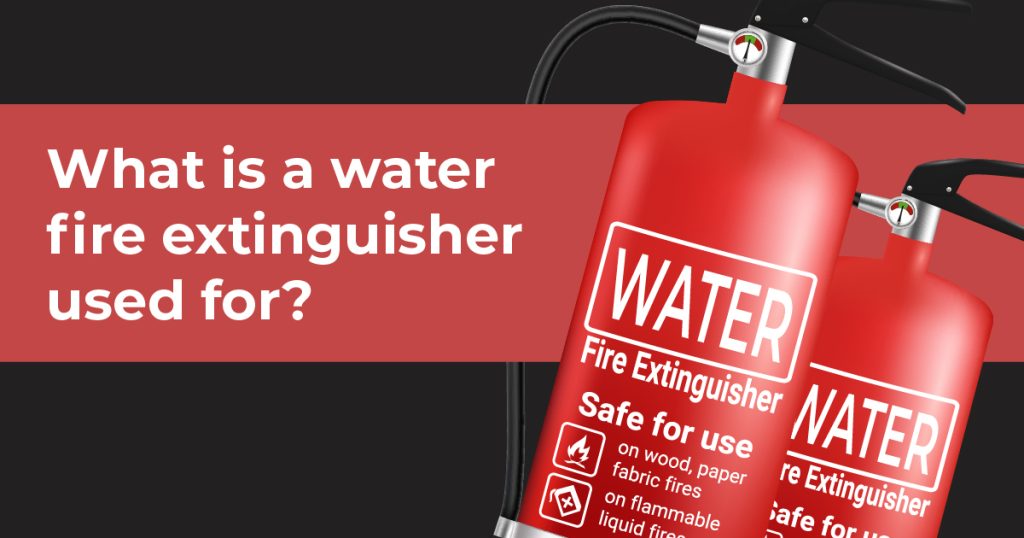Your basket is currently empty!
What Is a Water Fire Extinguisher Used For?
Possibly the single most common fire extinguisher type, water extinguishers are often found easily at hand because of their ability to help tackle fires that use organic materials as fuel.
So what do you need to know about water fire extinguishers? This month at Fire Safety Equipment, we’ll cover what they are, when to use them, how to operate them, when not to use them and talk about maintaining and replacing them.
This will give you all the information you need to help choose and use the right fire extinguisher for your premises. Our full range of fire extinguishers in our online store means you’ll always have access to everything you need in order to keep people safe.

What is a water fire extinguisher?
A water fire extinguisher is exactly what it sounds like, utilising water to suppress and extinguish a fire. The key aim of this extinguisher is to soak the material that has caught fire, lowering the temperature of it and thereby stopping the fire at the source.
Water fire extinguishers can be identified by their white label, with ‘Water’ written on them. They will feature a squeeze grip handle and a hose which can be used to direct the water spray.
What should you use a water fire extinguisher for?
Also known as a Class A fire extinguisher, water units should be used for fires that involve flammable organic solids. Common examples of this include paper, wood and textiles, where the material is aflame and can be effectively extinguished simply by using water in a powerful spray.
The water then soaks into the organic material to cool it and remove an important component of the fire triangle: heat.
A lack of chemicals also makes this extinguisher type safer to have in spaces around children and any vulnerable adults.
How to use a water fire extinguisher
Although water fire extinguishers are among the easiest to use, you should take the following steps when faced with a small fire:
- Remove the safety pin and any anti-tamper seal
- Keeping the extinguisher upright, hold the hose in one hand and the handle in the other
- Standing back from the fire, aim the nozzle of the hose at the base of the flames, preferably at the material itself that has caught fire if you can see it
- Squeeze the handle to release the water spray and completely soak the materials
- Use a sweeping motion as necessary and keep spraying until you are sure the fire is fully extinguished
We only recommend using a water fire extinguisher if you’re absolutely sure you can tackle it safely. Where you do not feel confident or where the fire is too large, always raise the alarm, evacuate and call the emergency services.
When should you not use a water fire extinguisher?
You should not use water fire extinguishers:
- when faced with electrical fires, this is due to the risk of electrocution and the damage that can be caused to infrastructure;
- when faced with flammable liquids like petrol and paint, as this could spread the flames;
- when faced with gas fires, including methane and butane, as the water will have no effect;
- when faced with cooking fires, such as chip pan fires, as this can splash and spread the flammable grease and fat.
A water fire extinguisher is only useful for tackling one type of fire, which is one of its main drawbacks if you have any materials that present a fire risk outside of organic fuels.
How to maintain a water fire extinguisher
As with any fire extinguisher maintenance, it’s important to be vigilant. This means conducting monthly visual inspections to assess any damage and ensure the unit has not been discharged. On top of this, annual basic servicing should be applied and extended servicing should be booked for every five years.
Where the anti-tamper seal has been removed, the unit should be replaced or recharged.
How often should you replace a water fire extinguisher?
A water fire extinguisher that has been discharged should be considered for replacement to ensure you have the best protection in place. There is no fixed lifespan for a fire extinguisher, but the recommended time for replacing them is after 10 years without use or damage. After this point, you may begin to see more extreme signs of deterioration.
What type of business needs water fire extinguishers?
As we’ve already mentioned, water fire extinguishers have a great general application. However, they’re often best used in businesses where there are large amounts of organic materials that could present a fire risk.
Having water extinguishers on hand in the following premises can help to soak the materials and quickly put out a fire:
- Paper production plants
- Storage units
- Textile factories
- Retail environments
- Warehouses
It’s recommended that water fire extinguishers are paired with other units to tackle the fire class that your business is most at risk of experiencing. This is often in the shape of CO2 fire extinguishers, helping to cover electrical risks, while foam fire extinguishers might be a superior choice if you want to cover both Class A and Class B fires.
Here at Fire Safety Equipment, you can find a huge range of water fire extinguisher types and sizes, including stainless steel options. This means you can get the right extinguisher type to help protect the lives of any residents, visitors or staff in your building.
Order online now to get all your essential fire safety equipment, eliminating the need to make multiple orders from various different companies. Contact us if you need additional advice, or simply purchase water fire extinguishers and anything else you need from our online store. We offer fast, free delivery in the UK so you’re never left short.